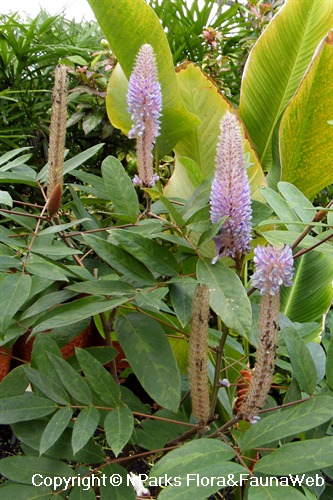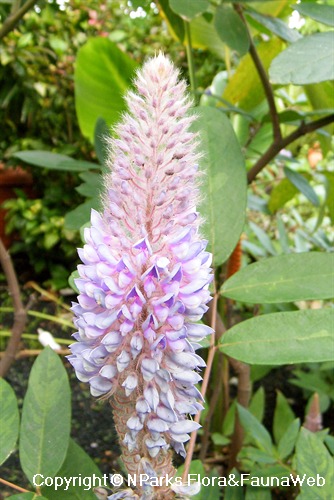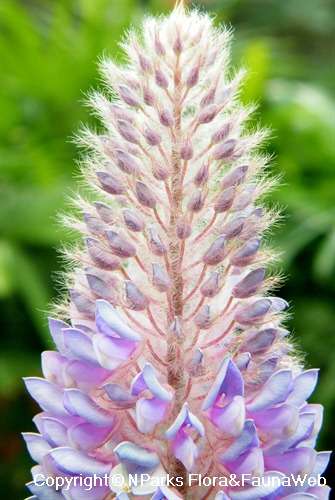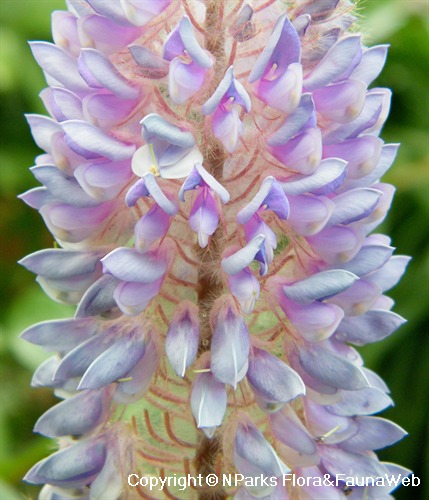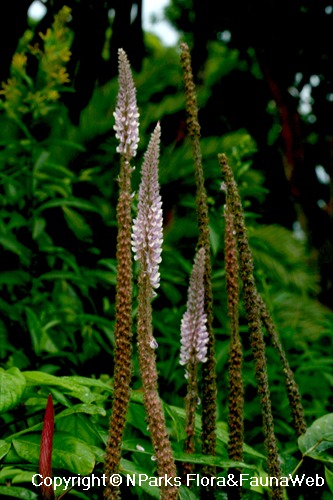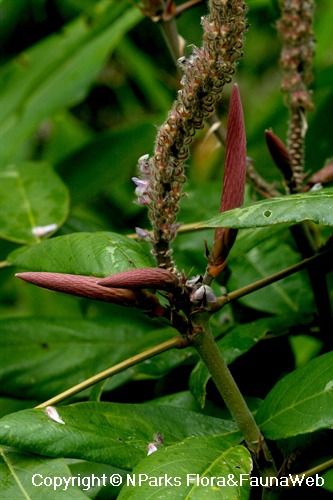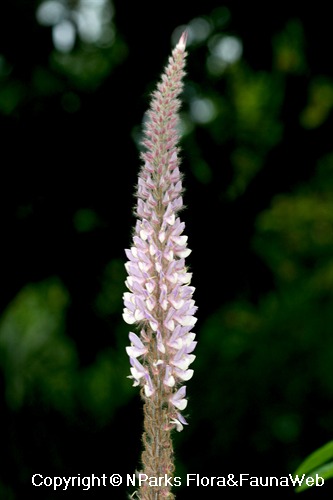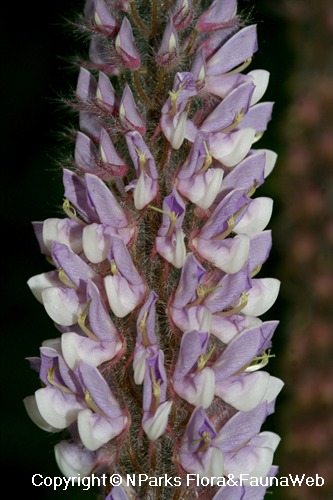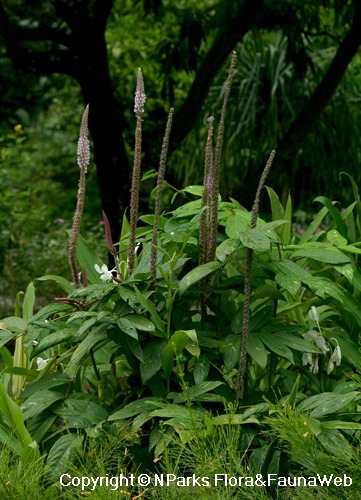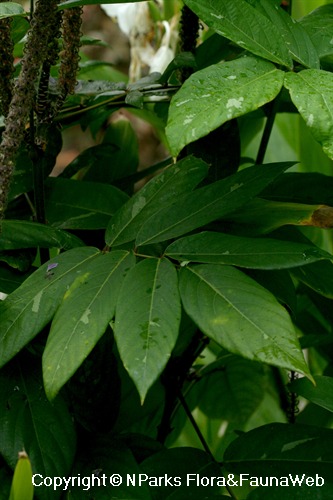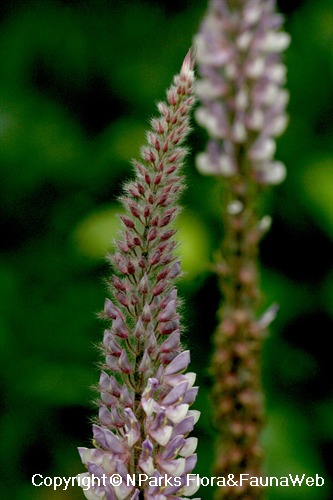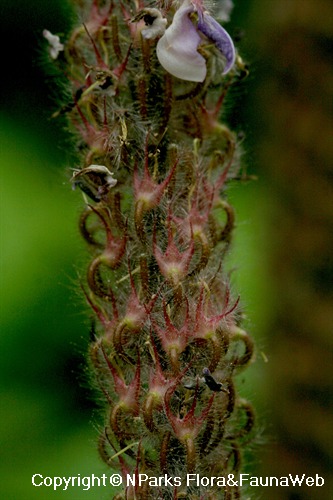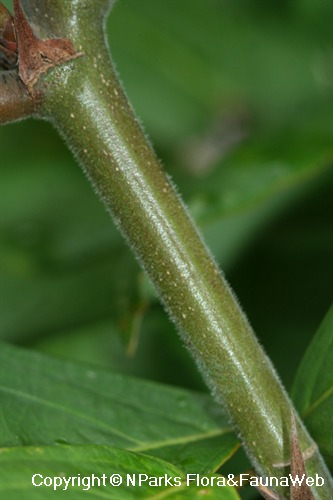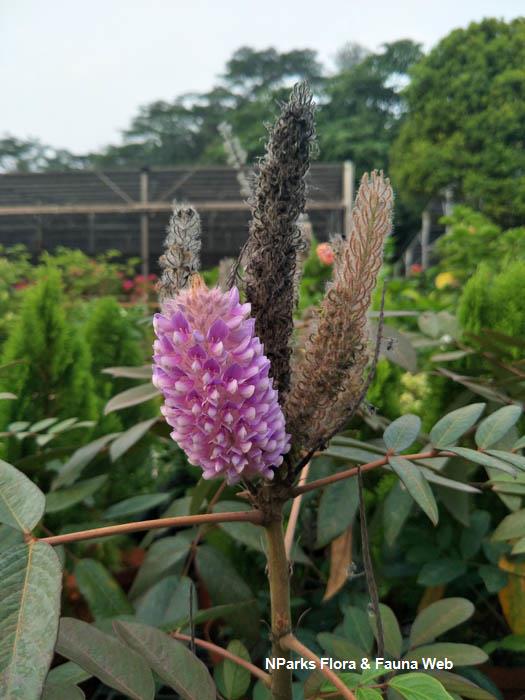
Back
Uraria crinita (L.) Desv. ex DC.
| Family Name: | Fabaceae (Leguminosae) |
| Synonyms: | Uraria crinita var. macrostachya, Abrus crinita, Uraria macrostachya, Uraria cornosa, Uraria comosa, Hedysarum crinitum, Hedysarum comosum |
| Common Name: | Asian Foxtail, Cat's Tail Plant, Pokok Ekur Anjing, Pokol Ekor Kuching, 猫尾草, 狗尾草, 兔尾草, 通天草 |
Asian Foxtail (Uraria crinita) has long bushy inflorescences of light purple flowers, resembling fox's tail. It prefers full sun for flowering and can tolerate a wide range of soils from nutrient poor soils to saline soils.
Name
Classifications and Characteristics
| Plant Division | Angiosperms (Flowering Seed Plants) (Dicotyledon) |
|---|---|
| Plant Growth Form | Shrub |
| Lifespan (in Singapore) | Perennial |
| Mode of Nutrition | Autotrophic |
| Maximum Height | 1 m to 1.5 m |
Biogeography
| Native Distribution | China, Taiwan, India, Southeast Asia |
|---|---|
| Native Habitat | Terrestrial (Grassland / Savannah/ Scrubland, Disturbed Area / Open Ground) |
| Preferred Climate Zone | Tropical |
| Local Conservation Status | Non-native (Spontaneous (Naturalised)) |
Description and Ethnobotany
| Growth Form | A woody shrub with erect stems and long bushy inflorescence. |
|---|---|
| Foliage | Leaves are pinnately compound with about 2 - 3 pairs of lateral leaflets and 1 slightly larger terminal leaflet. Leaflets are oblong to narrowly ovate (6 - 15 cm long, 3 - 8 cm wide). The petioles are often long (5.5 - 15 cm). |
| Stems | Stem covered in soft, short, grey hairs. |
| Flowers | Flowers have one large ovate petal that hangs over 3 smaller petals. (0.6 - 0.9 cm wide). Flowers are arranged on an inflorescence known as a raceme (an inflorescence with stalked flowers carried along 1 main axis). The inflorescence is light purple and shaped like a cone (15 - 30 cm long). This species flowers from April to September. |
| Fruit | Fruit is an elliptic pod lightly covered in soft, short hairs. |
| Habitat | Occurs in disturbed areas (eg., roadsides) and thickets. Found at altitudes from 0 - 900 m. In Thailand, it is considered a weed in rubber plantations. |
| Cultivation | This species should be planted in fertile, well-drained soil. It can tolerate and even ameliorate nutrient poor soils, because it has a mutually beneficial relationship with nitrogen-fixing bacteria. It also has some tolerance for saline soils. This species is suscepible to seed beetles from the family Bruchinae. |
| Etymology | The species epithet "crinita" is Latin for hairy. It might refer to the inflorescence's long white hairs. The common names of Cat's Tail and Asian Foxtail are derived from the inflorescence's resemblance to a bushy tail. |
| Ethnobotanical Uses | Food (Herb or Spice) Medicinal: This species is used in Chinese folk medicine to treat swellings and ulcers. Yen et al. (2001) found that the roots contain antioxidants. An extract prepared from the shoots has potential as a supplementary treatment for diabetes based on results from an animal model study (Liu et al. 2010). Others: It is also used as a green manure crop to improve soil quality. It has a symbiotic relationship with nitrogen-fixing bacteria that add nitrogen to the soil. The plants are grown on infertile cropland and then plowed into the soil to add organic matter. |
Landscaping Features
| Landscaping | This species is sometimes planted as an ornamental shrub, because it produces an abundance of large, light purple inflorescences. |
|---|---|
| Desirable Plant Features | Ornamental Flowers |
| Landscape Uses | General, Flowerbed / Border |
| Usage Hazard - Cons Remarks | Considered a weed in Thai rubber plantations |
Fauna, Pollination and Dispersal
| Pollination Method(s) | Biotic (Fauna) (Insects (Bee)) |
|---|
Plant Care and Propagation
| Light Preference | Full Sun |
|---|---|
| Water Preference | Moderate Water |
| Rootzone Tolerance | Fertile Loamy Soils, Well-Drained Soils, Poor Infertile Soils |
| Maintenance Requirements | Moderate |
| Diseases | Seed beetles |
| Propagation Method | Seed |
Foliar
| Foliage Retention | Evergreen |
|---|---|
| Mature Foliage Colour(s) | Green |
| Mature Foliage Texture(s) | Smooth |
| Foliar Type | Compound (Odd-Pinnate) |
| Foliar Arrangement Along Stem | Alternate |
| Foliar Shape(s) | Non-Palm Foliage (Ovate, Oblong) |
| Foliar Venation | Pinnate / Net |
| Foliar Margin | Entire |
| Foliar Apex - Tip | Acute, Obtuse, Rounded |
| Foliar Base | Rounded / Obtuse |
| Typical Foliar Area | Mesophyll ( 45cm2 - 182.25 cm2 ) |
| Leaf Area Index (LAI) for Green Plot Ratio | 4.5 (Shrub & Groundcover - Dicot) |
Non - Foliar and Storage
| Bark Colour(s) | Grey |
|---|---|
| Stem Type & Modification | Woody |
| Root Type | Underground (Tap Root) |
Floral (Angiosperm)
| Flower & Plant Sexuality | Bisexual Flowers |
| Flower Colour(s) | Purple |
|---|---|
| Flower Symmetry | Bilateral |
| Individual Flower Shape | Papilionaceous / Pea-shaped |
| Inflorescence Type | Raceme |
| Flowering Opening Time | Daytime |
| Flowering Habit | Polycarpic |
| Flowering Period Remarks | Flowers from April to September |
Fruit, Seed and Spore
| Fruit Classification | Simple Fruit |
|---|---|
| Fruit Type | Dehiscent Dry Fruit , Legume / Pod |
Image Repository
Others
| Master ID | 1244 |
|---|---|
| Species ID | 2537 |
| Flora Disclaimer | The information in this website has been compiled from reliable sources, such as reference works on medicinal plants. It is not a substitute for medical advice or treatment and NParks does not purport to provide any medical advice. Readers should always consult his/her physician before using or consuming a plant for medicinal purposes. |

